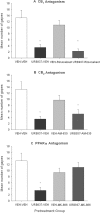Suppression of acute and anticipatory nausea by peripherally restricted fatty acid amide hydrolase inhibitor in animal models: role of PPARα and CB1 receptors
- PMID: 28805944
- PMCID: PMC5647182
- DOI: 10.1111/bph.13980
Suppression of acute and anticipatory nausea by peripherally restricted fatty acid amide hydrolase inhibitor in animal models: role of PPARα and CB1 receptors
Abstract
Background and purpose: Effective treatments of nausea are limited. In this study we evaluated the ability of the peripherally restricted fatty acid amide hydrolase (FAAH) inhibitor, URB937, to suppress acute and anticipatory nausea in rats and examined the pharmacological mechanism of this effect.
Experimental approach: We investigated the potential of URB937 (administered i.p.) to reduce the establishment of lithium chloride-induced conditioned gaping (model of acute nausea) and to reduce the expression of contextually-elicited conditioned gaping (model of anticipatory nausea) in rats. The role of CB1 receptors, CB2 receptors and PPARα in the anti-nausea effect of URB937 was examined. The potential of URB937 to suppress FAAH activity in tissue collected from the area postrema (AP), prefrontal cortex (PFC), liver and duodenum and to elevate levels of FAAH substrates - anandamide (AEA), N-oleoylethanolamide (OEO) and N-palmitoylethanolamide (PEA) - in the AP was also evaluated.
Key results: URB937 reduced acute nausea by a PPARα-dependent mechanism and reduced anticipatory nausea by a CB1 receptor-dependent mechanism. The PPARα agonist, GW7647, similarly attenuated acute nausea. URB937 reduced FAAH activity in the liver and the duodenum but not in the PFC. In addition, URB937 reduced FAAH activity and elevated levels of fatty-acid ethanolamides in the AP, a brain region that is not protected by the blood-brain barrier.
Conclusions and implications: The anti-nausea action of URB937 may occur in the AP and may involve PPARα to suppress acute nausea and CB1 receptors to suppress anticipatory nausea.
© 2017 The British Pharmacological Society.
Figures






Similar articles
-
The ventral pallidum as a critical region for fatty acid amide hydrolase inhibition of nausea-induced conditioned gaping in male Sprague-Dawley rats.Neuropharmacology. 2019 Sep 1;155:142-149. doi: 10.1016/j.neuropharm.2019.05.031. Epub 2019 May 28. Neuropharmacology. 2019. PMID: 31145905
-
Interference with acute nausea and anticipatory nausea in rats by fatty acid amide hydrolase (FAAH) inhibition through a PPARα and CB1 receptor mechanism, respectively: a double dissociation.Psychopharmacology (Berl). 2015 Oct;232(20):3841-8. doi: 10.1007/s00213-015-4050-7. Epub 2015 Aug 23. Psychopharmacology (Berl). 2015. PMID: 26297326
-
Characterization of the peripheral FAAH inhibitor, URB937, in animal models of acute and chronic migraine.Neurobiol Dis. 2021 Jan;147:105157. doi: 10.1016/j.nbd.2020.105157. Epub 2020 Oct 28. Neurobiol Dis. 2021. PMID: 33129939
-
A comparison of novel, selective fatty acid amide hydrolase (FAAH), monoacyglycerol lipase (MAGL) or dual FAAH/MAGL inhibitors to suppress acute and anticipatory nausea in rat models.Psychopharmacology (Berl). 2016 Jun;233(12):2265-75. doi: 10.1007/s00213-016-4277-y. Epub 2016 Apr 6. Psychopharmacology (Berl). 2016. PMID: 27048155 Free PMC article.
-
Regulation of nausea and vomiting by cannabinoids.Br J Pharmacol. 2011 Aug;163(7):1411-22. doi: 10.1111/j.1476-5381.2010.01176.x. Br J Pharmacol. 2011. PMID: 21175589 Free PMC article. Review.
Cited by
-
Endocannabinoid signaling in stress, nausea, and vomiting.Neurogastroenterol Motil. 2025 Mar;37(3):e14911. doi: 10.1111/nmo.14911. Epub 2024 Sep 2. Neurogastroenterol Motil. 2025. PMID: 39223918 Free PMC article. Review.
-
The Peripheral Cannabinoid Receptor Type 1 (CB1) as a Molecular Target for Modulating Body Weight in Man.Molecules. 2021 Oct 13;26(20):6178. doi: 10.3390/molecules26206178. Molecules. 2021. PMID: 34684760 Free PMC article. Review.
-
Oleoyl glycine: interference with the aversive effects of acute naloxone-precipitated MWD, but not morphine reward, in male Sprague-Dawley rats.Psychopharmacology (Berl). 2019 Sep;236(9):2623-2633. doi: 10.1007/s00213-019-05237-9. Epub 2019 Apr 16. Psychopharmacology (Berl). 2019. PMID: 30993360
-
Effect of combined doses of Δ9-tetrahydrocannabinol and cannabidiol or tetrahydrocannabinolic acid and cannabidiolic acid on acute nausea in male Sprague-Dawley rats.Psychopharmacology (Berl). 2020 Mar;237(3):901-914. doi: 10.1007/s00213-019-05428-4. Epub 2020 Jan 2. Psychopharmacology (Berl). 2020. PMID: 31897571
-
Effect of oleoyl glycine and oleoyl alanine on lithium chloride induced nausea in rats and vomiting in shrews.Psychopharmacology (Berl). 2022 Feb;239(2):377-383. doi: 10.1007/s00213-021-06005-4. Epub 2021 Oct 21. Psychopharmacology (Berl). 2022. PMID: 34676441
References
MeSH terms
Substances
Grants and funding
LinkOut - more resources
Full Text Sources
Other Literature Sources
Medical
Miscellaneous

